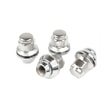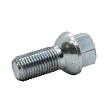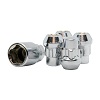Wheel alignment – what is it and how much does it cost?
Correct wheel alignment is the foundation of safe and comfortable driving. One of its key elements is wheel alignment , or the positioning of the wheels relative to each other and the vehicle's axle. Although many drivers are unaware of this, alignment directly impacts not only driving safety but also the vehicle's stability on turns, fuel economy, and even tire wear . Incorrect alignment is one of the most common causes of premature tire wear and vehicle pulling to the side.
In this article, we'll explain exactly what wheel alignment and geometry are, what parameters matter, what causes them to become misaligned, and what the consequences of neglect can be. We'll also advise how often it's worth checking the alignment, how much such a service costs at a workshop, and why it's not worth putting off. This compendium of knowledge will help every driver understand why wheel alignment is one of the most important, yet most often overlooked, elements in everyday car operation.

What are wheel alignment and geometry? – Basic definitions
Wheel alignment – precise definition
One of the most important parameters affecting a car's handling is wheel alignment. This is simply the angle of the wheels relative to the vehicle's longitudinal axis, measured horizontally—that is, when looking down at the car.
We can distinguish two basic types of convergence:
- positive toe-in – when the front edges of the wheels are directed inwards and the wheels themselves “come together”
- negative toe-in (toe-out) – when the wheels are set the other way around, i.e. they "spread" outwards
The angle you set has a huge impact on how your car handles while driving. Correct toe-in ensures your car remains stable on straight roads, and the steering wheel naturally returns to center after a turn. Improper wheel alignment leads to pulling, uneven tire wear, and increased driver fatigue. Therefore, the answer to the question "what is wheel alignment?" has a direct impact on driving safety and comfort.
Wheel alignment – a broader look at suspension parameters
While many drivers use the terms "toe-in" and "wheel alignment" interchangeably, in practice they don't mean the same thing. Wheel alignment is a much broader concept that encompasses the adjustment of all wheel angles and suspension components that affect a car's handling.
Convergence is therefore only one piece of the puzzle. Other important factors include:
- camber – the angle of the wheel's deviation from the vertical, affecting, among other things, traction in corners
- caster – a parameter that determines the stability of the car and the return of the steering wheel to the starting position
- lateral inclination of the kingpin axis (KPI/SAI) – affecting the lightness and precision of steering
Knowing the difference between an alignment and a full wheel alignment will help you better understand why a workshop inspection should cover all of these parameters, not just the forward wheel alignment.
Wheel geometry parameters – key angles that influence driving
Camber angle – impact on traction
One of the fundamental parameters of wheel alignment is the wheel angle, also known as camber. It is measured when viewing the vehicle from the front or rear, i.e., in a vertical plane.
We can distinguish two basic settings:
- Positive camber – when the top of the wheel is tilted outward. This results in less traction in corners but can improve straight-line stability.
- Negative camber – when the top of the wheel is angled inward. This provides greater tire-to-road contact in corners, improving traction, but excessive camber leads to faster wear on the inner edges of the tires.
In practice, car manufacturers select camber angles to achieve a compromise between cornering grip and even tire wear. In motorsports, greater negative camber is often used to maximize tire contact with the asphalt during aggressive driving.
Caster Angle – Stability and Steering
Another important parameter is the caster angle. This is measured by viewing the vehicle from the side. It is the angle between a vertical line passing through the kingpin axis and its actual axis of inclination.
Impact of the caster on vehicle handling:
- ensures directional stability, so the car does not "float" on the road,
- facilitates the automatic return of the wheels to the straight-ahead position after turning,
- improves the so-called steering feel, which gives the driver greater control over the car.
Casters can be compared to the wheels on a shopping cart – when set at the right angle, they always return to straight-ahead driving. In cars, this works on a similar principle – the greater the positive caster angle, the greater the stability at high speeds.
Kingpin axis inclination angle (KPI/SAI) – comfort and safety
The final key angle is the lateral angle of the kingpin axis, known as KPI (King Pin Inclination) or SAI (Steering Axis Inclination). This parameter determines how the kingpin axis is tilted relative to the vertical when looking at the car from the front.
Importance of KPI/SAI :
- in combination with camber, it determines the vehicle's stability in curves,
- reduces the forces acting on the steering system, making turning easier and less tiring,
- helps keep the car on the right track, increasing comfort and safety.
With the right KPI setting, the driver feels less resistance on the steering wheel and the vehicle is more predictable and stable both when turning and after exiting the curve.
Why does wheel alignment become out of alignment? – Common causes
| Cause | Description | Effect |
|---|---|---|
| Hits curbs/potholes | Even a slight impact can change the wheel angles. | The car starts to pull, the geometry deteriorates. |
| Road collisions | Small bumps affect the suspension and steering system. | The alignment needs to be readjusted. |
| Wear of suspension components | Bushings, pins and rod ends lose stiffness. | Looseness, unstable ride, poorer handling. |
| Dynamic driving over bumps | Frequent overloads cause gradual deregulation. | Gradual deterioration of steering precision. |
| Replacing suspension components | After replacing shock absorbers, wishbones, rods or steering rack. | Wheel alignment required. |
Regular wheel alignment checks save you money on tires, fuel, and ensure greater road safety.
The factory-set wheel alignment can change over time, even if the car hasn't been involved in a serious accident. This is influenced by both everyday driving conditions and the natural wear and tear of components. It's important to understand the most common causes so you can react promptly and prevent more serious driving problems.
Mechanical damage and daily use
One of the main causes of misalignment is sudden impacts and overloads transferred to suspension components. The most common causes include:
- hitting curbs, especially when parking,
- hitting holes and gaps in the road,
- the effects of even minor road collisions that can shift suspension components.
Dynamic driving on uneven roads or off-road also increases the risk of wheel alignment becoming out of alignment. Minor changes often go unnoticed by the driver, but they impact ride comfort and even tire wear.
Wear of suspension and steering components
The second important factor is the natural wear and tear of the suspension . As the car ages, individual components lose their properties and develop play, which impacts wheel alignment precision. The most vulnerable are:
- rubber-metal bushings in the wishbones
- pins, steering rods and their ends
- steering gear (so-called rack and pinion)
When play appears in the suspension, even the best-set geometry quickly loses its parameters and the car begins to "pull" or behave uncertainly in corners.
Parts replacement and service repairs
The final, but equally common, reason for changing wheel alignment is service intervention. After every major repair, wheel alignment should be checked – even if the car seems to be handling properly. This applies in particular to:
- replacement of shock absorbers
- replacement of control arms and bushings
- repairs related to steering rods or steering rack
Moreover, even replacing tires can have a minor impact on alignment, especially if the installation wasn't performed precisely. Therefore, professionals recommend performing a full alignment after any modification to the suspension or steering system.
What are the consequences of incorrect wheel alignment?
Improper wheel alignment is a seemingly trivial problem, but in practice it can significantly impact a car's comfort, safety, and operating costs. Many symptoms are noticed by drivers only after some time – when the tires are unevenly worn and the car is no longer handling smoothly. Below, we present the most common consequences of driving with misaligned wheel alignment.
Excessive and uneven tire wear – the hidden costs
One of the first and most visible effects is uneven tire wear. Typical patterns indicating improper alignment and geometry include:
- so-called "tread serration"
- wear of only one edge of the tire
- spot abrasions, especially visible with negative camber
The result? Wearing tires incorrectly shortens their lifespan by up to half. This means tires need to be replaced sooner, which generates additional and often high operating costs.
Deterioration of driving safety and comfort
Poorly adjusted wheel alignment also poses a direct threat to driving safety. This manifests itself in the following ways:
- the car pulling to one side despite holding the steering wheel straight
- the sensation of "car floating" and difficulty in maintaining the driving line
- crooked steering wheel despite driving straight
As a result, the driver loses full control of the vehicle – the vehicle becomes unstable in corners, braking distances increase, and the steering system reacts with delay. In emergency situations, this can mean a lack of precise vehicle response and a higher risk of collision.
Increased fuel consumption
Poorly aligned wheels mean higher rolling resistance. This, in turn, leads to increased engine load and higher fuel consumption. Even a slight discrepancy in wheel alignment can increase fuel consumption by several percent, meaning hundreds of zlotys extra spent at the gas station annually.
Additionally, other components are overloaded, such as the gearbox or drive system, which must compensate for the additional resistance.
Accelerated wear of suspension components
Improper wheel alignment angles cause forces acting on suspension components to be distributed unevenly. Accelerated wear most often occurs in:
- bolts
- wishbone bushings
- wheel bearings
- other components responsible for driving stability
The consequence is not only a deterioration in driving comfort but also more frequent visits to the workshop and more expensive repairs. Minor neglect can quickly lead to significant expenses.
How often should wheel alignment be performed and what is the cost of this operation?
Regular wheel alignment is an investment in safety, comfort, and savings. Although many drivers consider this procedure unnecessary, in practice it is one of the most important elements of proper vehicle operation. It's worth knowing how often to have your wheel alignment checked, what the service involves, and how much it costs in Polish garages.
Recommended frequency of geometry inspections and adjustments
General expert guidelines are quite clear: wheel alignment should be checked at least once a year or every 15,000–20,000 km . This standard interval allows for the detection of any discrepancies before they become costly.
In addition, there are situations in which control is mandatory:
- after every collision – even minor bumps can disrupt the steering system
- after hitting a curb hard or falling into a large hole
- after replacing suspension or steering components (wishbones, rods, shock absorbers, steering rack)
- after replacing tires with new ones, especially if we change the size or type of tires
Neglecting these points increases the risk of rapid tire wear and deterioration of vehicle handling.
What is a wheel alignment service? – The workshop process
Modern workshops use 3D computer systems or laser devices that allow them to determine all wheel parameters with extraordinary accuracy. The procedure is as follows:
- The car is placed on a special lift where the measuring heads are mounted.
- The computer system performs measurements with an accuracy of fractions of a millimeter.
- An experienced mechanic interprets the data and makes the necessary adjustments.
The entire process takes an average of 30 minutes to 1.5 hours, depending on the condition of the adjustment screws and the complexity of the suspension in a given model.
Cost of wheel alignment and full geometry – what influences the price?
Below are approximate prices for wheel alignment and wheel geometry in Poland. The cost of the service depends on the vehicle type, suspension complexity, and any adjustment difficulties.
| Scope of service | Price range (PLN) | Comments |
|---|---|---|
| Adjusting the convergence of one axis | 120 – 180 | Most often the front axle; quick correction after minor deviations |
| Full four-wheel geometry | 200 – 350 | 3D/laser measurement, alignment adjustment + camber/caster verification |
| SUV / sports / premium cars | 300 – 600 | More complex suspensions, more adjustment points |
| Removing rust / loosening seized screws | 50 – 150 | Added when adjustment is difficult (time + chemicals) |
| Checking the geometry after replacing tires | 0-100 | Often included in a service package; payable upon full measurement |
| Geometry diagnostics without adjustments | 80 – 150 | Printout of parameters; decision on adjustment after analysis |
| Geometry after suspension replacement | 250 – 450 | Full measurement and adjustment after service work |
The cost is influenced by, among others:
- vehicle type (SUV, premium car, sports car)
- type of diagnostic equipment (modern 3D systems are more expensive but more accurate)
- workshop location (large cities usually more expensive)
- condition of the adjustment screws (seizing extends the life and increases the price)
- reputation and experience of the service
Wheel alignment – an investment that pays off
While the cost of an alignment may seem like an unnecessary expense, in practice it's a procedure that quickly pays for itself. Correct alignment is:
- longer tire life (savings of up to several hundred zlotys per year)
- lower fuel consumption
- less load on the suspension
- and above all – greater driving safety
Therefore, regular wheel alignment is not an expense, but an investment in a longer car life and lower operating costs.




 Modern design
Modern design Perfect fit
Perfect fit High durability
High durability Free shipping within 24 hours
Free shipping within 24 hours
 Individual project
Individual project Dedicated caregiver
Dedicated caregiver








